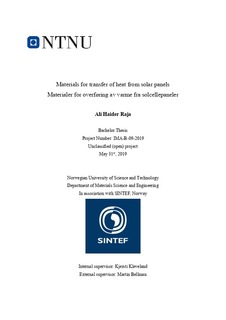| dc.description.abstract | En innovativ metode for å forbedre effektiviteten til fotovoltaiske (PV) solceller ved økt omgivelsestemperatur er å benytte et fotovoltaisk/termisk (PV/T) system. Systemet tilbyr en kjølemekanisme for PV-modulen ved å utnytte overflødig varme for rom- eller vannoppvarming. Dette arbeidet forsøkte å foreslå et termisk grensesnittmateriale (TIM), som gir maksimal varmeoverføring fra PV-modulen til varmematten. To scenarioer for en sandwichstruktur til et PV/T-system er undersøkt i denne rapporten, hvor varmematten var en aluminiumsplate. Scenario A siktet på å sette inn et TIM mellom en glass/glass PV-modul og aluminiumsplaten. Scenario B forsøkte å erstatte det bakre glasset til PV-modulen med en TIM. Arbeidet ble utført i to deler. Under den første delen ble eksperimentering utført ved hjelp av SINTEFs spesialbygde varmestrømningsapparat for begge scenarier. For den andre delen ble det gjennomført en studie om scenario B for tilgjengelig TIM på markedet; videre ble enkel Edu Pack modellering på kompositter gjort for å finne et godt valg for TIM.
Feil bruk av varmestrømningsapparatet innebar at størst varmeoverføring mellom PV-modulen og aluminiumsplaten ikke kunne bestemmes. Imidlertid viste apparatets innebygde monitorer at kobberteip som TIM for scenario A ga den største varmestrømmen, 96.9 W/m², og den laveste termiske isolasjonen, 0.14 m²K/W, gjennom sin sandwichstruktur. PVC-matte som TIM for scenario B hadde laveste varmestrømmen, 65.9 W/m², og den største termiske isolasjonen 0,24 m²K/W til tross for at den har den største temperaturendringer over sitt første og siste lag. Basert på studien var 5595 silisium/polyetylenmate levert av 3MTM den mest lovende kandidaten til eksperimentering basert på termisk ledningsevne, elektrisk isolasjon og pris. Edu Pack-modellering viste at fylling av en polyimidmatrise (PI) med termisk ledende fyllstoffer som heksagonal bornitrid (h-BN) og alumina (Al2O3(85)) forbedrer termisk ledningsevne for kompositten. Ved fyllfraksjoner større enn 40% påvirker fyllstoffets varmeledningsevner den samlede termiske ledningsevne for kompositten betraktelig. Tilsvarende volumfraksjon ved 50.6% i en h-BN/PI-kompositt gir 34% høyere termisk ledningsevne og 3 ganger lavere elektrisk resistivitet enn dens Al2O3(85)/PI motpart. h-BN-kompositten viste bedre ytelse enn Al2O3(85) kompositten, og bør utforskes i fremtiden for å vurdere om h-BN-komposittene vil gi størst termisk ledning fra PV-modulen til varmematten. | |
| dc.description.abstract | An innovative method of enhancing photovoltaic (PV) solar cell’s efficiency upon increased ambient temperature is by utilizing a photovoltaic/thermal (PV/T) system. This is a hybrid structure which has a PV system adhered to a multi-functional solar collector. Consequently, PV/T system offers a cooling mechanism for the PV module by exploiting its excess heat for space or water heating. This research attempted to propose a thermal interface material (TIM) which offers maximum heat transfer from the PV module onto the heat mat. Two scenarios for a sandwich structure of a PV/T system are investigated in this report where the heat mat is mimicked by an aluminium plate. Scenario A aimed at inserting a TIM between a glass/glass PV module and the aluminium plate. Scenario B aimed at replacing the rear glass of the PV module with a TIM. This investigation was conducted in two parts. Firstly, experimentation using SINTEF's custom-built heat flow apparatus was done for both scenarios. Secondly, a desk study on scenario B for TIMs available in the market was conducted; furthermore, to find a theoretically suited TIM, Edu Pack modelling on composites was done.
Incorrect use of the heat flow apparatus resulted in the error in the experimental results. Thus, the greatest heat transfer between the PV module and the aluminium plate could not be determined. However, the in-built apparatus' monitors revealed that copper tape as TIM for scenario A offered the greatest heat flux, 96.9 W/m2, and the lowest thermal insulance, 0.14 m2K/W, through its sandwich structure. PVC pad as TIM for scenario B offered the lowest heat flux, 65.9 W/m2, and the greatest thermal insulance 0.24 m2K/W despite having the greatest temperature difference across its first and last layer. Based on the desk study, 5595 Silicone/polyethylene pad supplied by 3MTM was the most promising candidate for experimentation based on its thermal conductivity, electrical insulation and price. Edu Pack modelling showed that filling a polyimide (PI) matrix with thermally conductive fillers like hexagonal boron nitride (h-BN) and alumina (Al2O3(85)) enhances the thermal conductivity of the composite. At filler loadings greater than 40%, the thermal conductivity of the filler influences significantly the total thermal conductivity of the composite. Equal filler volume fraction of 50.6% in a h-BN/PI composite offers 34% greater thermal conductivity and 3 folds electrical resistivity than the its Al2O3(85)/PI counterpart. The h-BN composite exhibited better performance than Al2O3(85) composite. | |
